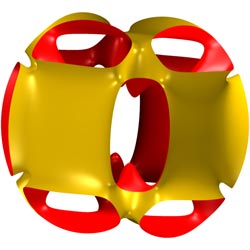
Enhancing Robot Movement Control Through Gymnastics Techniques

The objective of the research is to improve the control of robot movements with the help of new mathematical approaches. For this purpose, the primary focus lies on the identification of situations in which a collision may occur and the planning of an optimal motion path. Crucial factors for the initiation of this project were new developments in the areas of motion planning, computer-aided design and algebraic geometry. Within the framework of this project, algebraic methods for the control of robot motions are being used for the first time in combination with numeric and geometric methods.
A robot is born, so to speak, with motor skills. By way of program codes, motor skills are deposited into its microprocessor-based memory device. This is how motion patterns are defined, but they are not always safe for the environment – or for the robot itself. They also do not always live up to the users´ expectations regarding the efficiency of the robot´s performance. These limitations partly result from the mathematical approaches that are chosen for the calculation of the motion patterns. It is now the aim of a research group led by Prof. Manfred Husty and Prof. Hans-Peter Schröcker at the Faculty of Civil Engineering of the University of Innsbruck to develop new approaches for more safety and efficiency.
SMOOTH LIKE A ROBOT
Within the framework of this project, which is supported by the Austrian Science Fund FWF, “robots” take on a quite general meaning. Be it an industrial robot or R2D2 – they all must first and foremost perform safely. “Safe means that a robot does not collide with its environment or with itself while performing its tasks. It also has to avoid what we call dangerous areas. This does not, however, involve physically present obstacles, but positions in the proximity of which the robot cannot be controlled due to geometric reasons, and thus may become dangerous. In robotics, we also call these areas singularity,” explains project leader Prof. Schröcker.
Naturally, there are a number of methods available for calculating such areas and for avoiding them when programming motion patterns. However, according to Prof. Schröcker, all of these methods have one thing in common: “The methods that have been applied thus far are based on numeric calculations. These are not accurate. They also don´t allow a guarantee that all dangerous areas have been considered in the calculations. Algebraic methods, however, are not only more accurate, but could also allow such a guarantee.”
Roughly speaking, numerics deal with solving continuous mathematical problems by means of discretised computer calculations. Algebra, however, uses variables, which allows for more accurate and more comprehensive calculations. In recent years, algebraic methods have in fact become increasingly popular in Mechanical Sciences. And the first theoretical results for their application in the area of robot motion are also available. These have, however, not yet been adapted to the practical requirements of mechanical engineering. This is exactly what is being done in this current project.
THE JOURNEY IS NOT THE DESTINATION
Developing new mathematical methods aims at ensuring not only that robots optimally avoid “dangerous” areas, but also that they carry out motion sequences as efficiently as possible; in this context, efficiency can mean “using the shortest route” or “quickly”, “elegantly” and “in an energy-saving manner”. When calculating the necessary paths, possible collisions and “dangerous” areas must be considered, as Prof. Schröcker explains: “The calculations can be thought of as connecting points in space by means of smooth curves which remain sufficiently far away from the areas that are to be avoided. Developing adequate methods for doing so is an essential objective of this FWF project that will combine fundamental mathematics and practical use.”
Scientific contact:
Prof. Hans-Peter Schröcker
University of Innsbruck
Technikerstraße 13
6020 Innsbruck
T +43 / (0)512 / 507 – 6835
E hans-peter.schroecker@uibk.ac.at
Austrian Science Fund FWF:
Mag. Stefan Bernhardt
Haus der Forschung
Sensengasse 1
1090 Vienna
T +43 / (0)1 / 505 67 40 – 8111
E stefan.bernhardt@fwf.ac.at
W http://www.fwf.ac.at
Copy Editing & Distribution:
PR&D – Public Relations for Research & Education Mariannengasse 8
1090 Vienna
T +43 / (0)1 / 505 70 44
E contact@prd.at
W http://www.prd.at














